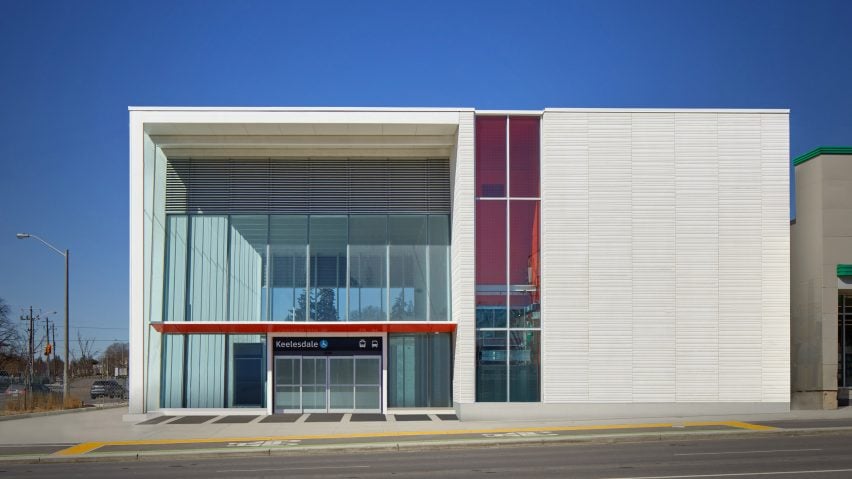Montreal architecture studio Daoust Lestage Lizotte Stecker has created a modular design system for the new Eglinton Crosstown light rail stations in Toronto.
The Eglinton Crosstown LRT runs 19.5 kilometres east to west across Toronto, and while construction is complete, according to local sources, the line is yet to open to the public.
Daoust Lestage Lizotte Stecker (DLLS) led the design of the project, which included the creation of 15 underground and 10 above-ground stations, as well as its graphic identity.
DLLS worked with Arcadis, the technical lead on the project, and with Canadian architecture studios Dialog and Norr on the creation of individual stations.
The studio created a "kit-of-parts" design to implement across all 25 train stations, which included architectural elements such as a glass box volume, double-height spaces underground and transparent cladding.
It distributed these elements across three main station typologies: pavilion, corner, and embedded.
"The kit-of-parts approach was developed to ensure consistent design from the scale of the city to the object," said the team. "Three distinct station typologies - pavilion, corner, and embedded - were developed to be responsive to the genius loci of each station site."
The entrance to each station is "a pristine and welcoming glass box", either slanted or upright, featuring slim vertical glass panels, textured precast concrete panels and a horizontal canopy.
"The opaque technical building is encircled by an envelope of luminous, textured precast concrete panels, resonating with Toronto's civic buildings," said DLLS partner Rachel Stecker.
"The precast concrete panels, inspired by the geological layers of the soil, vertically connect the street to the concourse level."
These glass and concrete panels are distributed in a 1.5-metre rhythm, which the studio notes is for ease of replacement over the line's lifetime in the pursuit of sustainability.
The transparent panels also bring light into below-ground spaces.
"As passengers descend into the station, the slanted ribs of the glass box echo their movement and create dynamic plays of light and shadow along the textured wall," said the team.
"Double height volumes from concourse to platform create openness within each station, allowing travellers to clearly understand the route to the train."
Inside, the stations are largely clad in white and punctuated with public art and colourful wayfinding to create a "museum-like ambience".
The team worked predominantly with a bright orange, as the line is set to be the orange line once opened.
"As a city building project, ECLRT represents a unique opportunity to formalize an architectural signature, from civic scale to the finest detail, while respecting the genius loci of Toronto's diverse and constantly evolving neighbourhoods," said DLLS partner Renée Daoust.
Other projects in Toronto include Rafael Viñoly Architects' first Canadian project and an angular house with diamond-shaped cladding.
The photography is by Tom Arban
Project credits:
Design excellence lead: Daoust Lestage Lizotte Stecker
Design team: Renée Daoust, Rachel Stecker, Nathalie Trudel, Marie-Josée Gagnon, Réal Lestage, Eric Lizotte, Caroline Beaulieu, Lucie Bibeau, Maria Benech, Alexandre Boulianne, Dominique Morin-Robitaille, David Gilbert
Joint venture partners: Crosslinx Transit Solutions Design Team:
Crosslinx transit solutions constructors: Consortium of ACS Dragados, Aecon, Ellis Don and Atkins Realis
System-wide technical lead: Arcadis
Design Per station: Daoust Lestage Lizotte Stecker (Fairbank Station), DIALOG and Arcadis (Forest Hill, Chaplin and Avenue Stations),
Arcadis (Mount Dennis, Keelesdale, Oakwood, Eglinton, Leaside, Laird, Science Centre and Kennedy Stations and At-grade Stops), NORR (Caledonia, Cedarvale and Mount Pleasant Stations)
Project client: Metrolinx and Infrastructure Ontario

